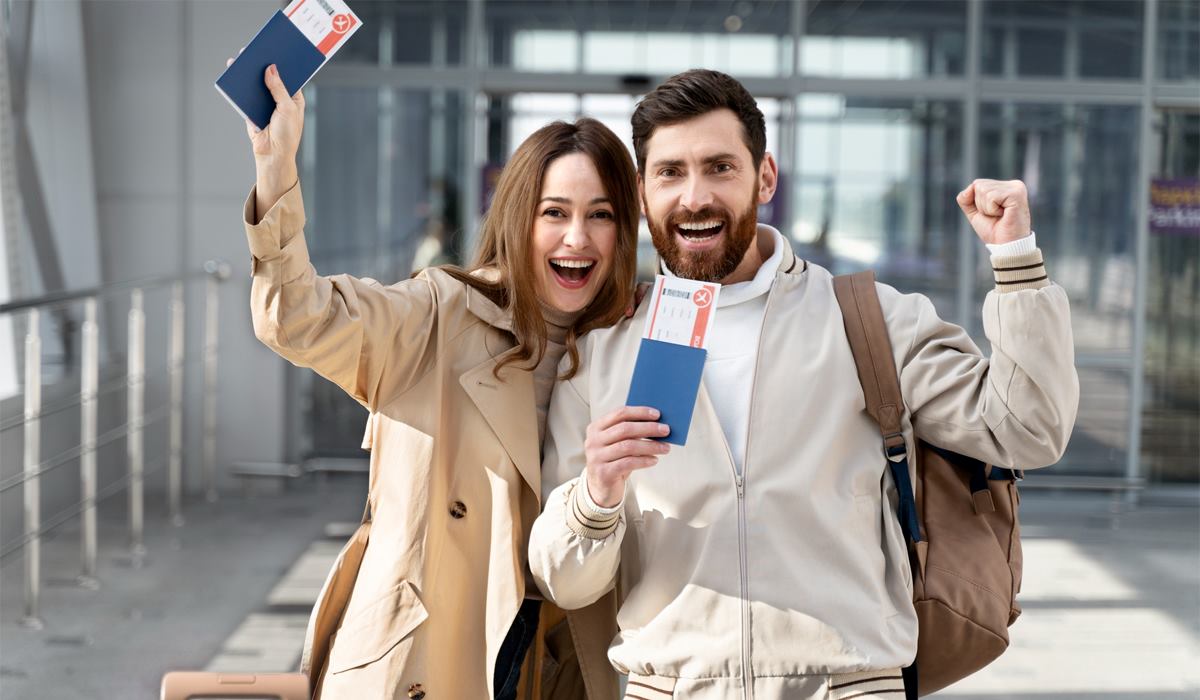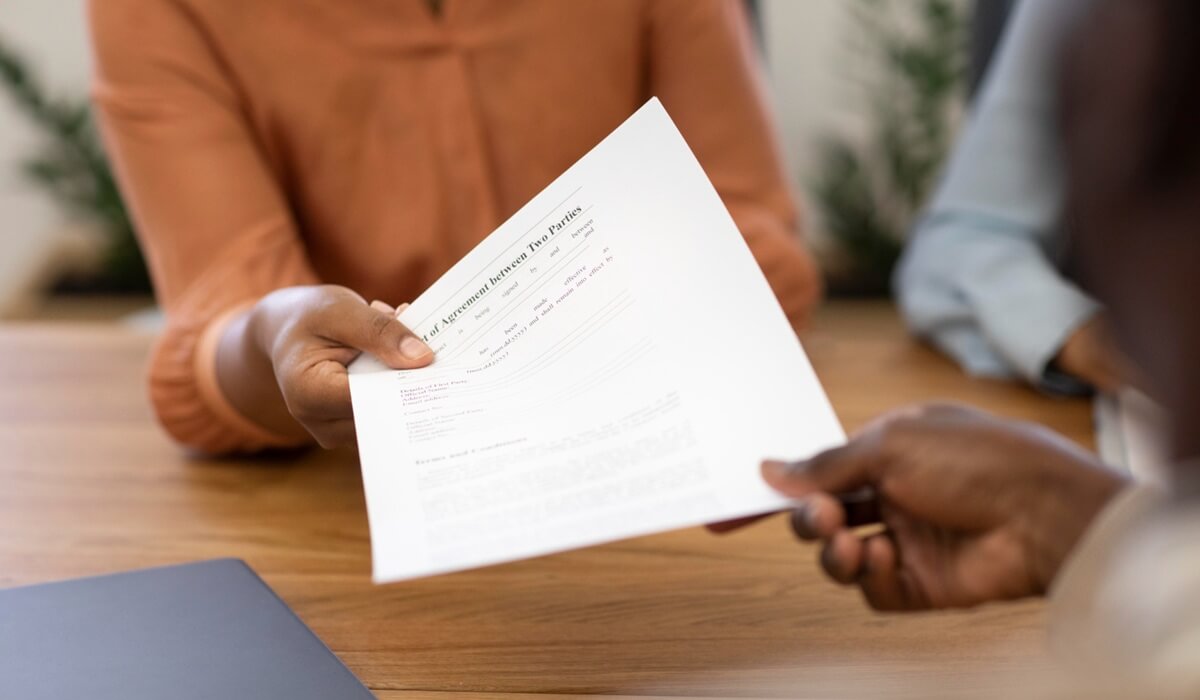J1 Visa Explained: The Complete Exchange Visitor Guide
- Published by Max-B.
- July 17, 2025
- 21 min read
Table of Contents

If you’re planning to come to the US for an academic, cultural, or professional exchange, the US J1 visa might be the perfect path. This visa is designed to promote mutual understanding between the US and other countries.
Figuring out the process and rules can feel overwhelming. That’s why we’ve broken it all down in this simple, complete guide.
What is a J-1 US Visa?
The J1 visa is also called the Exchange Visitor Visa. It’s made for people who want to study, teach, research, or work in the US for a short time as part of an official exchange program. These programs are approved by the US Department of State, and they’re meant to help people from around the world learn, share ideas, and build international friendships.
But here’s the catch: you need a sponsor. This is usually a school, nonprofit group, or government program that’s officially allowed to invite you.
The J1 visa isn’t just one type of program. It actually includes 16 different categories. Each one is for a specific kind of visitor:
- Au Pair (live with a host family and help with childcare)
- Camp Counselor (work at a summer camp)
- College and University Student (study in a US college or university)
- Secondary School Student (attend a US high school)
- Government Visitor
- International Visitor
- Physician
- Professor
- Research Scholar
- Short-Term Scholar
- STEM Initiatives
- Specialist
- Summer Work Travel
- Teacher
- Trainee
- Intern
Now, here’s something important: many J1 visa holders must go back to their home country for at least two years after their program ends. This rule is called the two-year home residency requirement. It’s meant to make sure you share what you’ve learned in the US with your own country. But if there’s a special reason, like danger back home or a unique career need, you might be able to apply for a waiver.
What Are the J1 Visa Requirements?
The J1 visa comes with US visa rules, and they matter. Let’s check the J1 visa requirements you need to meet:
- Have a sponsor. You must be funded or accepted by a recognized sponsor.
- At least 50% of your program funding must come from your J1 visa sponsor. Money from family or friends doesn’t count toward this.
- Meet the English language requirements of your host institution.
- You and your dependents must have valid medical insurance that meets J-1 program standards.
- The sponsor must give you pre-arrival info and conduct an orientation. Attendance is required.
- Maintain full-time status, follow all visa conditions, and stay in contact with your sponsor.
- After your program, you may need to return to your home country for two years (Two-Year Home Residency Rule).
- Your passport must be valid for at least six months beyond your program end date.
- Remain enrolled in full-time study or training during your program.
- Only work on campus, max 20 hours/week during school. Full-time during breaks. Off-campus work requires approval.
- Report any US address change to your sponsor and school within 10 days.
J1 Visa Requirements And Eligibility Based on Category
Au Pair
Requirement | Details |
Age | 18–26 |
Offer Required | Job offer from U.S. host family |
Health | Must be in good health |
Experience | Previous childcare experience |
Language | English proficiency |
Education | Secondary school education |
Driving | International license + 50+ hours driving |
Smoking | Non-smoker if required by family |
Legal | Police clearance report |
Training | 32 hours of childcare training |
Limits | Max 10 hrs/day, 45 hrs/week |
Education | Must complete 6 academic credit hours |
Host Family Must Provide | Room, board, $500 toward education, and compensation per FLSA |
Camp Counselor
Requirement | Details |
Age | 18+ |
Eligibility | Foreign student, youth worker, teacher, or has special skills |
Language | English proficiency |
Duration | Up to 4 months, no extensions |
Compensation | Pay + housing + meals equal to U.S. counselors |
Restrictions | Cannot be kitchen, janitorial, or office staff |
College and University Student
Requirement | Details |
Enrollment | Full-time at U.S. accredited college/university |
Academic | Must maintain good standing |
Funding | Must come from sponsor/government/institution |
Agreement | Must be part of a formal exchange agreement |
Secondary School Student
Requirement | Details |
Age | 15–18.5 at program start |
Education | No more than 11 years completed |
Prior Exchange | Cannot have done U.S. high school exchange before |
Housing | Host family or boarding school |
Jobs | Not allowed (except babysitting, yard work) |
Duration | One academic year max |
Living | Cannot live with relatives |
Government Visitor
Requirement | Details |
Selection | By U.S. federal/state/local government agency |
Activities | Tours, discussions, training, meetings |
Purpose | Build ties with U.S. professionals |
International Visitor
Requirement | Details |
Selection | By U.S. Department of State |
Profile | Must be leader or rising expert in field |
Purpose | Build international personal and professional networks |
Physician
Program Type | Requirement |
Clinical | English fluency, passed USMLE/ECFMG/VQE/NBME exams |
Clinical | Statement of need from home country |
Clinical | Signed agreement with U.S. training institution |
Non-Clinical | Activities: teaching, research, observation, consulting only |
Non-Clinical | Must be certified by sponsor or medical school dean |
Professor and Research Scholar
Requirement | Details |
Duration | Max 5 years |
Restrictions | No tenure-track jobs; no J-1 in past 12–24 months |
Language | Must speak English fluently |
Subcategories | Professor (teach), Research Scholar (research) |
Short-Term Scholar
Requirement | Details |
Role | Lecturer, researcher, consultant, trainer |
Duration | Max 6 months, no extension |
Return | May return later under different program |
Bars | Not subject to 12/24-month bar unless rejoining same sponsor |
Specialist
Requirement | Details |
Skills | Must have specialized skills/knowledge |
Duration | Max 1 year |
Limits | Cannot fill permanent jobs |
Fields | Education, law, science, media, public admin, etc. |
Summer Work Travel
Requirement | Details |
Eligibility | Full-time post-secondary students outside U.S. |
Education | At least one semester completed |
Language | Must speak English well |
Job Offer | Required unless from visa waiver country |
Duration | Max 4 months (summer only) |
Jobs | Hospitality, tourism, parks, restaurants, media, etc. |
Financials | Proof of funds if job not arranged |
Teacher
Requirement | Details |
Role | Teach in U.S. K–12 schools |
Duration | Up to 3 years |
Education | Must meet home country teaching qualifications |
Experience | 3+ years teaching or related work |
Language | Must speak English |
References | Required from employers/colleagues |
Assignment | Must teach at school listed on DS-2019 |
Trainee
Requirement | Details |
Education/Experience | Degree + 1 year experience OR 5 years experience |
Age | 20+ |
Language | English fluency (test, school, or sponsor interview) |
Fields | Media, law, science, business, education, agriculture, etc. |
Intern
Requirement | Details |
Enrollment | Enrolled in foreign post-secondary institution OR graduated within past 12 months |
Age | 18+ |
Language | English fluency (test, school letter, or sponsor interview) |
Field | Training must relate to current/recent studies |
Working Outside the Program
Rule | Details |
Main Rule | Work only for sponsor unless authorized |
Students | Can work on-campus (linked to scholarships) |
Off-Campus | Only in urgent need or summer work/travel |
Limit | 20 hrs/week during school, full-time during breaks |
Standing | Must remain in good academic standing |
STEM Initiative
Requirement | Details |
Eligibility | Students or professionals in Science, Technology, Engineering, or Math fields |
Purpose | Promote collaboration in STEM between the U.S. and partner countries |
Activities | Research, teaching, training, or internships in approved STEM fields |
Funding | Must be supported by a designated sponsor with a STEM-specific program |
Duration | Varies by sub-program (usually matches College/University or Research Scholar limits) |
Restrictions | Must meet regular J-1 requirements, including English proficiency and insurance coverage |
How to Apply for a J1 Visa?
For a successful J1 visa application, you must complete several required steps in a specific order. Each step involves forms, fees, and deadlines that must be followed exactly:
Step 1: Find and Apply to a Designated Sponsor
You cannot apply for a J1 visa without first being accepted by an official US Department of State–designated sponsor. Here’s what to do:
- Go to the official list of sponsors on the US State Department website.
- Find a sponsor that offers your specific j1 visa jobs and program type (e.g., Intern, College Student, Teacher, Au Pair).
- Contact the sponsor directly and apply for their program. Each sponsor has its own application process and deadlines.
- Submit any documents the sponsor requires (application form, resume, academic transcripts, English proficiency test scores, references, etc.).
- Wait for an acceptance letter or offer from the sponsor. You cannot move to Step 2 until you are officially accepted and have a sponsor assigned.
Step 2: Receive Form DS-2019 (Certificate of Eligibility)
Once accepted into the sponsor’s program, the sponsor will issue Form DS-2019. This is your official Certificate of Eligibility for J-1 status. You cannot apply for a visa without it.
Important Notes:
- The form is issued and signed by your Responsible Officer (RO) at the sponsor organization.
- It contains details, like your name, SEVIS ID, program dates, category, sponsor, and estimated funding amount.
- If your spouse or children are joining you, they must each have a separate DS-2019 form issued in their name.
- Review your DS-2019 form carefully. Make sure all information is correct. Do not make changes yourself.
- You will need to show this form during your visa interview and upon arrival in the US.
Step 3: Pay the SEVIS I-901 Fee
After receiving your DS-2019, you must pay the SEVIS I-901 fee to the US Department of Homeland Security. This SEVIS fee is separate from your visa application fee. Sponsors do not always cover it.
How to pay:
- Go to the official payment site (https://fmjfee.com).
- Enter your SEVIS ID number from your DS-2019 form (begins with “N00…”).
- Complete the online form with your personal information exactly as shown on the DS-2019.
- Pay the fee using a credit card or debit card.
- Print the confirmation receipt immediately after payment. You must bring this to your visa interview.
Fees (as of July 2025)
J-1 Category | SEVIS Fee |
Most J-1 categories | $220 |
Au Pair, Camp Counselor, SWT | $35 |
Government-sponsored programs (G-1, G-2) | Exempt |
Step 4: Complete Form DS-160 (Nonimmigrant Visa Application)
This is your official visa application form. Every J-1 applicant must complete it online before scheduling the interview. You need to:
- Go to the US Department of State’s DS-160 site.
- Select your country and begin a new application.
- Write down your Application ID. You’ll need it to return to your form if you stop midway.
- Complete the form fully and accurately with your personal information, passport details, travel plans, education and work history, etc.
- Upload a recent passport-style photo that meets US visa photo guidelines.
- Review everything, submit the form, and print the confirmation page with the barcode.
Note: You must bring the DS-160 confirmation page to your interview. Without it, your appointment will be canceled.
Step 5: Pay the Visa Application Fee
After completing the DS-160, you must pay the nonimmigrant visa application fee, also known as the MRV fee. It is $185 (as of July 2025), it’s non-refundable, and you must pay before your interview. How to pay:
- Go to the website of your local US Embassy or Consulate.
- Follow their instructions for payment (online bank transfer, over-the-counter bank payment, or local currency option).
- Save the payment receipt and bring it to your interview.
Note: You may be exempt from paying this fee if:
- You’re sponsored by the US government (e.g., Department of State, USAID).
- Your program is officially listed as government-funded.
Step 6: Schedule Your Visa Interview
Next, you must book an interview at your nearest US Embassy or Consulate. This is required for most J-1 applicants. Before you start, you need to gather your DS-160 confirmation number, SEVIS ID (from your DS-2019), MRV fee receipt, and passport details. To schedule:
- Visit the US visa appointment website for your country.
- Create a profile and log in.
- Select “Schedule Appointment”.
- Enter your DS-160 confirmation number, visa type (J-1), and SEVIS info.
- Choose your interview location, date, and time.
- Schedule appointments for any dependents (J-2 applicants) if needed.
Step 7: Attend Your Visa Interview
This is a required in-person interview with a US consular officer. The officer may approve, deny, or delay your visa based on your eligibility and documents.
Bring these documents to the interview:
- Passport (valid for at least 6 months beyond your program end date)
- DS-160 confirmation page with barcode
- Visa fee payment receipt
- Form DS-2019 (signed by your sponsor)
- I-901 SEVIS payment receipt
- Visa photo (if not uploaded online)
- DS-7002 (if applying for the Intern or Trainee program)
- Academic documents (transcripts, diplomas, test scores)
- Proof of funds (bank statements, scholarship letters, sponsor confirmation)
During the interview:
- Answer clearly and honestly
- Expect questions about your program, goals, funding, and future plans
- You must prove your intention to return home after your program
Step 8: Receive Your J1 visa
If approved, the consulate will keep your passport temporarily to place the visa inside. They will return it within a few days to a few weeks by mail or pickup (depends on location).
Check your visa:
- Make sure your name, date of birth, and visa category (J-1) are correct
- Verify your program dates match your DS-2019
Step 9: Make Travel Arrangements
Important rules:
- You may enter the US up to 30 days before the program start date on your DS-2019.
- You cannot enter after the program start date unless cleared by your sponsor.
Before traveling:
- Double-check that your passport and J1 visa are valid.
- Carry all original documents in your hand luggage, including your passport with visa, DS-2019, SEVIS payment receipt, sponsor/employer contact info, and yravel insurance (if applicable).
Step 10: Check In With Your Sponsor After Arrival
Once you arrive in the US, you must report your arrival to your J-1 sponsor. This is not optional. You need to:
- Contact your sponsor within 30 days of the program start date listed on your DS-2019.
- Your sponsor will give you specific instructions for checking in. This is often done through an online portal or email.
- You will likely need to submit your US address, a copy of your I-94 arrival record, and confirmation that you’ve arrived and started your program.
- The sponsor will then activate your SEVIS record, which officially starts your J-1 status.
Important:
- If you don’t check in, your SEVIS record will not be activated. This means you’ll be considered out of status, and your visa may be terminated.
- You also cannot apply for a Social Security Number (SSN) or start work until your sponsor activates your record.
Do You Need a J1 Visa Work Permit?
Whether or not you need a separate work permit depends on your J-1 program type. But all work must be approved by your sponsor. Unauthorized work can lead to visa termination.
If Your Program Includes Work (e.g., Intern, Trainee, Au Pair, Summer Work Travel):
- You don’t need a separate work permit. Your Form DS-2019 + sponsor approval allows you to work.
- You must only work in the job listed in your program.
- You can’t change jobs or add a second one without sponsor approval.
If You’re a J-1 Student:
You can work on- or off-campus, but you must follow strict rules and get written approval from your sponsor. To get J-1 work authorization as an academic student:
- Talk to your J-1 sponsor (RO or ARO). You can ask about your work options: on-campus work or Academic Training (AT) for off-campus jobs. You need to get written permission for each job.
- Submit required documents, including your job offer letter, proof of full-time enrollment and good standing, SEVIS ID, and DS-2019 copy.
- Get a written letter of work authorization. Your sponsor will give you a signed letter or updated DS-2019. This is your legal work permit.
- Apply for a Social Security Number (SSN). It is required to begin work. Visit the local SSA office with your passport with J1 visa, DS-2019, I-94 record, and work authorization letter from the sponsor.
You can work:
- On campus: up to 20 hours/week during school, full-time on breaks
- Off campus: only if part of an approved academic training program
- You must get written permission from your J-1 sponsor before working
J1 Visa Duration
The length of your J1 visa depends on the program category and the dates listed on your DS-2019 form. Most J1 visas last from a few weeks to 5 years.
For example:
- Camp Counselor / Summer Work Travel: up to 4 months
- Au Pair: up to 12 months, with a possible 12-month extension
- Research Scholar / Professor: up to 5 years
- Intern / Trainee: 12 to 18 months
- College/University Student: for the length of your degree program
J1 Visa Processing Time
The average J1 visa processing time is 4 to 8 weeks (from sponsor acceptance to visa in hand), but delays are possible, especially during peak seasons. Typical timeline include:
Stage | Estimated Time |
Sponsor program application | Varies (few days to several weeks) |
DS-2019 form issuance | 2–4 weeks after acceptance |
SEVIS fee payment & DS-160 form | 1–2 days |
Embassy interview scheduling | Varies by country (1–60+ days) |
Visa interview to visa issuance | 7–15 days (can be longer) |
What is the J1 Visa Grace Period?
After your J-1 program ends, you get a 30-day grace period. It allows you to pack up and leave the US, travel within the US, and prepare for your return home. But during this grace period, you cannot work, you cannot study, and you cannot leave and re-enter the US on the same J1 visa.
Remember that your DS-2019 end date marks the end of your program, not your visa stamp. The grace period starts the day after that. If you overstay past the 30 days, you may face serious immigration consequences. Always leave or change your status on time.
Can You Get a J1 Visa Extension?
Yes, you can extend your J1 visa, but only in certain cases and only if your program sponsor allows it. Just remember that you cannot extend your stay just to travel or stay longer without a valid academic or training reason.
Here are the general rules for J1 visa extensions:
- You must apply before your current DS-2019 end date.
- The sponsor must agree and issue a new DS-2019 with updated dates.
- The total stay cannot exceed the maximum duration allowed for your specific program category.
Maximum Duration by Program
Program Type | Max Duration (Including Extensions) |
Au Pair | 12 months + possible 12-month extension |
Research Scholar | 5 years total |
Professor | 5 years total |
Intern | 12 months |
Trainee | 18 months (or 12 for hospitality) |
Short-Term Scholar | 6 months (no extension allowed) |
Summer Work Travel | 4 months (no extension allowed) |
College/University Student | Length of program + academic training |
How to Apply?
- Talk to your sponsor early. They decide if an extension is possible.
- Sponsor issues a new DS-2019 with a new program end date.
- Pay the SEVIS fee again if required (depends on the program).
- No need to leave the US. You stay on the new DS-2019 dates.
J1 Visa Health Insurance Requirements
If you’re coming to the US on a J1 visa, you must buy health insurance. It’s not just for yourself, but also for any J-2 dependents (spouse or children). You must have your insurance in place within 30 days of arrival. Without it, you’re not in compliance with your visa terms, and your SEVIS record can be terminated.
Your insurance must meet ALL of the following:
Coverage Area | Minimum Requirement |
Medical benefits per accident or illness | At least $100,000 |
Medical evacuation to home country | At least $50,000 |
Repatriation of remains | At least $25,000 |
Deductible per accident or illness | No more than $500 |
Policy must be underwritten by | An insurance company with at least an A- rating or be backed by the U.S. government |
Pre-existing condition waiting period | Reasonable (varies by provider, often 6–12 months) |
You will be required to attest that your health plan meets these rules after attending International Orientation.
Can You Bring Your Family on a US J1 Visa?
If you hold a J1 visa, your legally married spouse and unmarried children under the age of 21 are eligible to apply for J-2 dependent visas. Each J-2 family member must have their own DS-2019 form and a valid passport. They also need to obtain a J-2 visa from a US embassy or consulate, unless they are Canadian citizens, who do not need a visa stamp to enter the US.
To apply for a J-2 visa, you’ll need to provide proof of your relationship, which includes a marriage certificate for your spouse and birth certificates for your children. These documents must be translated into English if they are in another language. J-2 dependents may enter the US with you or after you, as long as your J-1 program has not changed since their DS-2019 forms were issued. There is no requirement for J-2 family members to enter the US within 30 days of the DS-2019 start date.
However, there are some restrictions. J-2 visa holders are not easily allowed to switch to a J-1 Research Scholar visa, due to the 24-month bar on repeat participation. If a J-2 dependent wants to work in the US, they must apply for separate employment authorization by filing Form I-765 with USCIS.
Other relatives, such as parents, siblings, or cousins, are not eligible for J-2 status. They may visit the US as tourists through the Visa Waiver Program (for up to 90 days if eligible) or by applying for a B-2 tourist visa.
Two-Year Home Residency
Some J1 visa holders are subject to a two-year home residency rule, also called Section 212(e). This means that after finishing their J-1 program, they must return to their home country and live there for a total of two years before they can apply for certain US immigration benefits. If the J1 visa holder is subject to this rule, then all J-2 dependents (spouse or children) are also subject. Also, this rule is listed on the second page of your DS-2019 form, and should be discussed clearly with your program sponsor.
This rule applies if the J-1 visitor wants to:
- Get an H, L, or K visa
- Apply for a green card
- Change to another visa status inside the US.
You are subject to the two-year rule if:
- Your program is funded by your home government, the US government, or an international agency supported by government funds.
- Your home country is on the US Department of State’s Skills List, and you studied or worked in one of those high-demand fields.
- You came to the US for clinical training under ECFMG (Education Commission for Foreign Medical Graduates) sponsorship.
In many cases, the J1 visa holder may request a waiver if they meet specific conditions and get approval from both their home government and the US Department of State. Waivers are common in cases involving medical research, government interest, or hardship to family members.
How to Start a New J-1 Program?
The US government places limits on how often you can participate in J-1 Exchange Visitor programs, especially if you’ve already completed one. These limits are known as the 12-month bar and the 24-month bar.
If you’ve finished a J-1 program, or if you’ve stayed in the US for a long time in a certain J-1 category, you might not be able to start a new J-1 program right away, especially in the Research Scholar or Professor categories.
You should always check these waiting periods before planning a new J-1 program:
J Visa Category | If You Were in the U.S. Less Than 6 Months | If You Were in the U.S. More Than 6 Months |
J-1 Research Scholar | 24 months | 24 months |
J-1 Short-Term Scholar | No wait | No wait |
J-1 Specialist | No wait | 12 months |
J-2 Dependent of Research Scholar/Professor | 24 months | 24 months |
J-2 Dependent of Short-Term Scholar | No wait | No wait |
J-2 Dependent of Specialist | No wait | 12 months |
Even if a bar does not officially apply, the US government may still expect you to have a significant break between two J-1 programs. This is especially true if the programs are similar in type or purpose.
How to Change Your Start Date?
If you won’t be able to arrive in the US within 30 days before or 15 days after the start date listed in Section 3 of your DS-2019, you must inform your sponsor immediately.
- If your new arrival date is within 3 months of your original start date, submit the appropriate form to notify the Office for Global Professionals and Scholars (GPS) of your new proposed start date.
- If your new arrival date is more than 3 months later than the original, contact your hiring department instead. They’ll need to file a new J-1 request for you.
The Bottom Line
The J1 visa opens doors to incredible opportunities in the US, from cultural exchange to professional training. But it also comes with important rules, time limits, and paperwork that you need to get right. Knowing the process helps you avoid delays and surprises.
If you need help at any stage, the experts at Visa Library offer FREE visa consultations. We’re here to guide you every step of the way.
FAQs
How long can I stay in the US on a J1 visa?
You can stay for the length of your program as listed on your DS-2019, plus a 30-day grace period after it ends.
Which visa is better: J-1 or H-1B?
It depends. J-1 is for temporary cultural and educational exchange; H-1B is for long-term employment in specialty occupations.
Can I work in the US with a J1 visa?
Yes, but only in jobs approved by your sponsor. Some categories allow work; others don’t. Always check with your program sponsor.
What should I do with my old DS-2019 forms?
Keep them. They are official records and may be needed for future visas, work permits, or immigration applications.
Do I need Form DS-7002 to apply for a J1 visa at a US embassy or consulate?
Only if you’re applying as an Intern or Trainee, other categories don’t require it.
How long does it take to get a J1 visa in my passport?
It usually takes 5 to 15 business days after the visa interview, but it can vary by country and consulate.
Can my spouse or partner work in the US on a J-2 visa?
Yes, a legally married J-2 spouse can apply for work authorization (Form I-765) after arriving in the US.
Can I apply for another J1 visa after my current program ends?
Yes, but you may face a 12- or 24-month bar depending on your category and length of stay. Check with your sponsor.
What should I do if my visa is in administrative processing?
Wait for further instructions from the embassy or consulate. It’s common and may take several weeks or more.
Why do I need a DS-2019 form?
It proves your eligibility for the J1 visa and lists your program details. You cannot apply for the visa without it.
- Author
- Max-B.
- July 17, 2025

Sign Up to Online Course
Related Articles

H4 Visa for Dependents: Requirements & Process
If your spouse or parent is coming to the US on an H-1B or other H-class visa, chances are you

H1B Visa: The Complete Guide for 2025
So, you want to work in the US? Awesome! But wait, what’s this H-1B visa everyone keeps talking about? Is

The Ultimate Guide to the DS-160 Form
Filling out the DS-160 form is the very first step when you apply for a US nonimmigrant visa, and it

